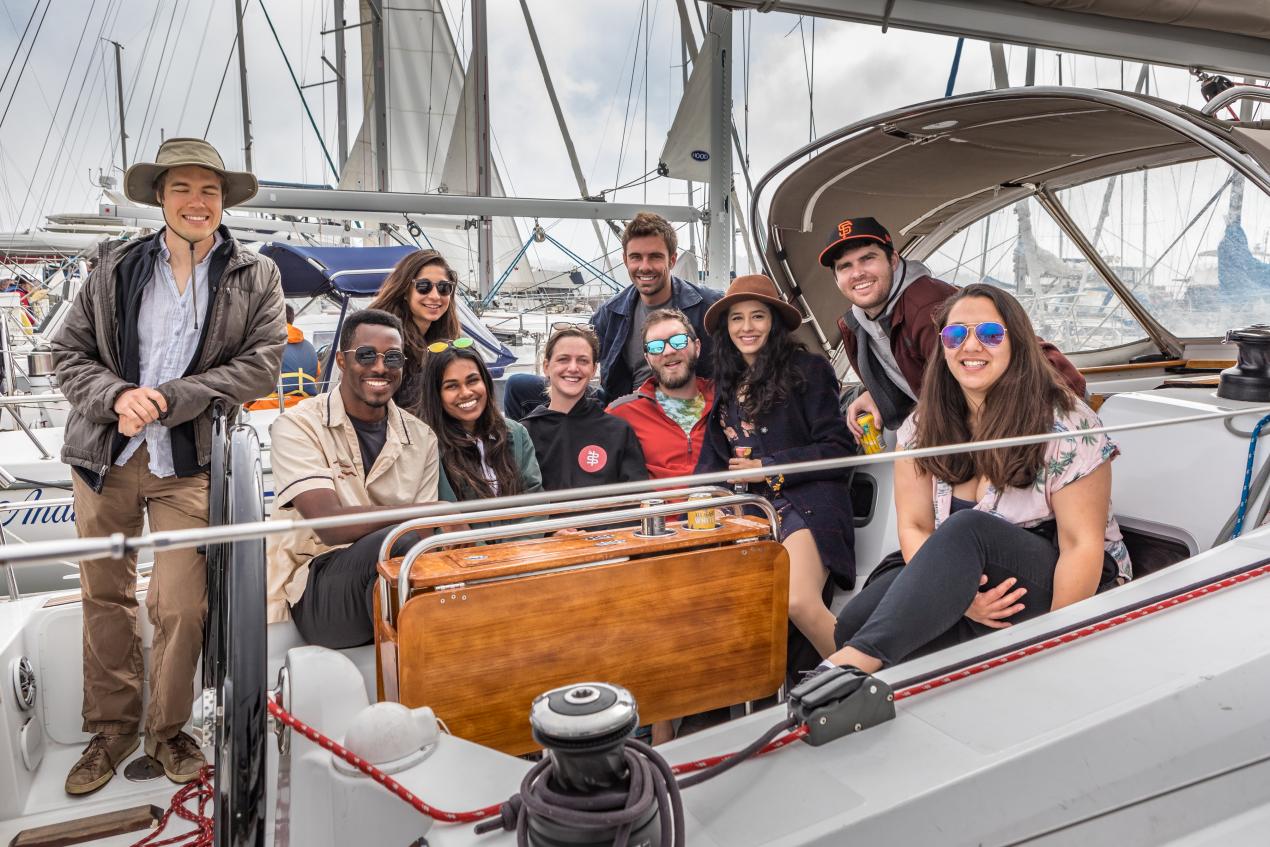
Modern Sailing bareboat charter skippers are required to bring one or more crew members aboard before heading out for a sail. Although we train and vet skippers to ensure they have what it takes to safely operate a sailboat, we don’t ask skippers about the experience level of their charter guests. Choice of crew is entirely up to the skipper, and it's also up to the skipper to ensure that everyone aboard has some basic knowledge to contribute to a safe and enjoyable day on the water.
Assess your own skills and experience honestly and use your best judgement when it comes to sailing with inexperienced guests. Unless you’re a highly experienced skipper, when all your guests seem to be inexperienced, it's safest to recruit at least one skilled sailor to join you. (If you need some help finding crew, we recommend using the members-only email Crew List or Facebook Crew List.)
Keep in mind that everyone (including the skipper), will have a lot more fun when the tasks involved with operating a sailboat are shared with at least one competent crew member. Also, a skilled crew member aboard can free up your attention so that you can focus on sharing some basic skills with the noobies who are excited to learn and participate.
Regardless of your crew’s experience level, you’ll increase your odds of a safe and enjoyable sail and enable your crew members to cope with unforeseen challenges by providing a thorough pre-departure safety briefing. The crew briefing is especially necessary whenever you take on guests who lack sailing experience and/or when you are chartering a boat that is unfamiliar to your crew. Even if you're going to sail on a familiar boat with familiar crew, a quick briefing is still a good way to validate their knowledge. It can be easy for anyone to forget some of the basics if they haven't been sailing regularly.
Before the Day of Your Sail
Take the time to communicate with your crew members by email or phone to assess their sailing experience. This knowledge will help guide how much detail you need to go into during the pre-departure briefing. Also, try to find out how much each person will want to participate in the sailing activities, or whether they want to just sit back and enjoy the ride as a guest. Ensure that inexperienced guests understand the importance of appropriate footwear (non-skid, non-marking soles) and know how to dress for comfortable sailing on the Bay.
If any of your guests or crew members are concerned about seasickness, send them a link to our article 10 Tips to Prevent and Remedy Seasickness. (Some measures to prevent seasickness must be taken in advance of the sail.)
Also, before the day of your sail, everyone will want to be aware of the following MSC charter policies:
- Only the skipper of record or qualified co-skipper can maneuver boats in and out of dock slips.
- The legal limit set by the US Coast Guard for all boats is 12 people. All our boats have an individual Bareboat Capacity Recommendation that is based on how many people can sail comfortably. (For more information on bareboat capacity, see article Choosing the Right Boat for Your Charter)
- Pets are not permitted on boats.
- Fishing gear of any kind, including crab pots, are prohibited.
- Modern Sailing sailboats are a smoke-free zone everywhere onboard.
- Red wine stains decks and interiors and is not permitted aboard.
- Anyone (skipper or guest) deemed intoxicated at the time of an accident will be fully responsible for all bodily injury or property damage as a result of that accident. Also, you are not covered by insurance if intoxicated.
The Day of Your Sail
Appoint your most competent crew member as first mate and ensure this person understands how to start/stop the engine, use the VHF radio, douse or furl sails, and steer. If your first mate is not very experienced, take the time to provide some one-on-one instruction before you head out.
Before you leave the dock, follow the crew briefing checklist below to help you inform your crew of the most essential details. These items are critical as they are related to safety and will help prevent injuries or damage to the vessel. With this checklist, we’ll provide a few additional fine points about some items. Below this list, you’ll find a more concise version in PDF format that you can print out, laminate or insert in a sheet protector, and keep in your gear bag.
Pre-sail Safety Briefing Checklist
Below Deck
- First aid kit location
- Fire extinguishers / fire blanket locations
- pull pin, point at base of fire, squeeze handle
- Location of wooden plugs
- Seacock locations, how to tell if a seacock is open or closed
- What to do if the boat is taking on water
- Flares location and how to use flares safely
- Airhorn – when and how to use
- VHF radio location, how to use, when to call securité, pan-pan, or mayday
- Securité: to inform other mariners of hazards to navigation, such as large debris floating in the water, or a disabled vessel anchored in a channel
- Pan-pan (pronounced "pahn-pahn”): to inform other vessels, the Coast Guard, and/or Vessel Assist of urgent situations that are not immediately life-threatening, such as your vessel is disabled, or you are lost in fog
- Mayday: for life-threatening emergencies only, such as fire aboard or imminent sinking of the vessel
- Batteries – switch location(s) and power management
- See article Marine Battery and Power Management Basics
- Lifejackets
- The US Coast Guard requires that children under the age of 12 must wear lifejackets on boats
- San Francisco Bay is cold – hypothermia can quickly disable even strong swimmers
- Head
- Operation
- Do not flush anything unless you’ve eaten it first
- Dispose of tissue paper and sanitary products in waste basket
- Electric heads - use a minimal amount of water when flushing, holding tanks can fill quickly
- Hatches
- Locations
- How to open and close
- Close hatches before leaving the dock
- Always keep hatches closed when under way
- Safety risks (slips, trips, and snags)
- Propane Stove
- Propane tank location and valve
- LPG solenoid switch
- Risks, precautions
- How to light and extinquish
- Boat iceboxes and refrigerators
- Turn off refrigerator/freezer before disconnecting from shore power
- See Charter Boat Icebox and Refrigerator Best Practices
- Boat’s white binder (ship’s papers)
- Boat Inventory on cover of binder
- SeaTow membership card
- Insurance documents
- Alcohol consumption
- Okay to consume but do so responsibly - do not get intoxicated
- Moving around the boat safely below deck
- “One hand for you, one hand for the boat.”
- Handhold locations: overhead rails and fiddles on galley counters, salon table, etc.
- Where to stow gear down below
On Deck
- IMPORTANT! Manage dock lines carefully to avoid “prop wrap”
- Pull lines aboard quickly when leaving the dock slip
- Stow all dock lines in lockers, do not tie in larksheads on the lifeline or pulpit
- For more information, see It’s Easy to Prevent the Costly Consequences of Prop Wrap
- Engine controls
- How to start and stop engine
- How to shift into forward, reverse, neutral
- Instruments
- Cockpit lockers and their contents
- Emergency tiller location
- Demonstrate how to attach
- Anchor and windlass
- Safe operation
- Ensure bitter end of rode is connected to a strong attachment point in the anchor locker
- Always start engine before operating windlass
- Crew overboard recovery equipment – throwable PFDs, ie, Type IV square, LifeSling, horseshoe buoy, ring buoy
- Mainsail - understanding proper use
- See Sailing with Lazy Jacks and Stack Packs
- See The Ins and Outs of Furling Mainsails
- Reefing and unreefing the mainsail
- Sail care / sail damage prevention
- Coast Guard Rule # 5 - crew must always be on watch
Crew Health
- Injury Prevention
- “One hand for you, one hand for the boat!”
- Boom – “jibe ho!” = watch your head
- Slips/trips prevention
- Winches and clutches – safe use (thumbs to the heart, do not wrap lines around hands)
- Stay on the windward side when moving forward on deck
- See Common Sailing Injuries and How to Prevent Them
- Seasickness – how to avoid, what to do when feeling queasy
- Food and drink
- Eat small, frequent meals or snacks
- Drink plenty of water to remain hydrated
- Alcohol and caffeine will increase the risk of dehydration
Want to learn more about crew leadership? These courses will help develop your skipper skills:
- ASA 103, Bareboat Cruising
- ASA 104, Bareboat Cruising
- ASA 106, Advanced Coastal Cruising
- Club Skipper Clinic
The Crew List is an email distribution list administered by Modern Sailing. To join the Crew List, please send an email to office@modernsailing.com.
Did you find this article helpful or informative? There's more where it came from! You'll become a better sailor when you read the educational articles in the Member Resources section of our website. Check it out!
Article by Mary Elkins on September 23, 2021
Updated April 13, 2023
Photo credit: Lyon Omohundro


